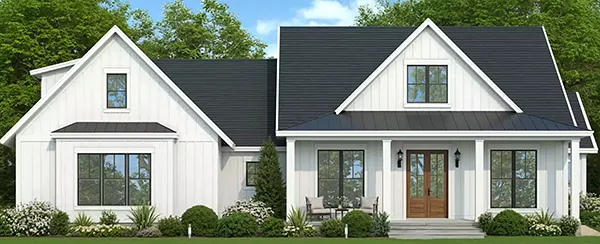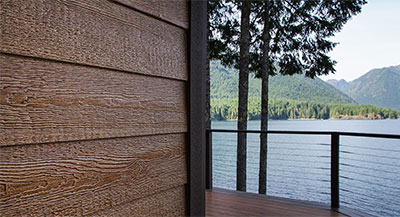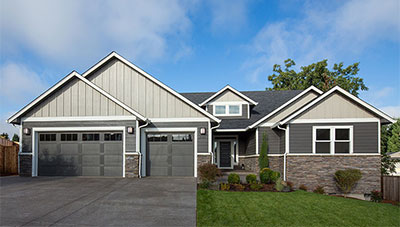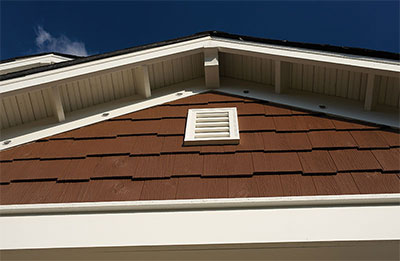Why Engineered Wood Is a Solid Siding Choice
by Rachel Lyon, Editorial Director for The House Designers®
Homes are covered in great swaths of siding, which is a big investment. So, it’s important to choose a product that is both durable and beautiful. It’s understandable if you’re unsure which material to invest in with so many diverse options in the market today! Each type of siding has its best uses and pros and cons, but here’s why so many homeowners building across the entire United States think engineered wood is a great choice.
With its deep grain texture, you might be surprised to learn that this is an engineered product and not solid boards.
LP® SmartSide® Lap Siding is available with the look of cedar or a smooth finish.
Natural Beauty
You might be wondering exactly what engineered wood siding is. Natural wood is at the core of its construction, and that means you can benefit from that inherent warmth and beauty—the reasons why most people seek out its raw form in the first place.
Engineered wood siding boards are created by pressing treated wood flakes together under high heat and pressure. The continuous grain pattern that is instilled on the surface is accepted well by the material and mimics the look of solid wood. You’ll appreciate the consistency in quality, which makes it easier to finish as desired because there aren’t tricky natural variables like large knots and non-matching colors to deal with. Engineered wood is available in popular siding styles including lap, panel, shake, and board and batten, so you can give your home the look it was designed for without worry or compromise.
Other types of manmade siding that have taken the top ranks in popularity over the last few decades just can’t compete with the appeal of wood. Vinyl has become the go-to option in the industry due to its low cost and quick installation, but it leaves much to be desired on the aesthetic level; even when imprinted with woodgrain texture, it looks and feels plasticky and far from real. Fiber cement siding also offers faux-wood style, but due to the nature of cement, it can reveal itself as an imposter with efflorescence and delamination. Anybody who wants a real wood look for their home would do well to purchase siding that contains it as a main component.
Defense Against the Elements
Well, why not cut out the manufacturing process and just use natural wood siding? There are many reasons why we have moved on from this old favorite; not only is it very expensive and difficult to come across these days, but it doesn’t meet our modern expectations in terms of durability and upkeep. The nostalgia for wood siding is definitely seen through rose colored glasses, because most of us don’t want to take the time or money to reseal it every year or two, and that means this organic material will be open to rot and insect invasion. That’s not the best first line of defense for your home!
Engineered wood siding offers increased hardiness and moisture resistance compared to solid lumber. Flaked wood is treated with zinc borate to resist fungal decay and termites, waxes to prevent moisture intrusion, and binders that hold it all together and help it withstand impacts like those from hail and wayward balls. All of this adds up to a supremely durable product because the treatment is full thickness, not just a topcoat that can wear down. Each panel of siding is also wrapped up in a resin-saturated overlay to form an even, impervious surface that accepts paint well and promises a long-lasting finish. Who knew wood could offer so much environmental resistance and convenience!
Sustainability and Eco-Friendliness
Synthetic products often promote themselves as more environmentally conscious, but you have to look deeper than source to determine the best green choice. While vinyl siding doesn’t require harvesting forests, its manufacturing releases dioxins—dangerous, carcinogenic toxins that persist in the environment—and still more are released at the end of its life cycle when it’s thrown away, because recycling isn’t an option in most areas. Phthalates are also a significant component of vinyl, and plenty of carbon dioxide and other harmful gases are released during production. Fiber cement usually produces less carbon dioxide, but it is heavy and transportation emissions are higher. There’s a lot of give and take to consider when comparing products, but wouldn’t it be great to have an option that actually absorbs some carbon?
Trees do just that, sequestering carbon dioxide from the atmosphere as they grow. Cutting them down for lumber might seem counterintuitive, but it can be done sustainably. While solid wood siding requires large trees that take a long time to mature and provide vital ecological services, engineered wood siding makes use of fast-growing, smaller trees. They have to be flaked to be treated, so their size isn’t much of an issue and all of the tree is used in the process. The treatment that makes the siding so economically attractive is also environmentally safe, so you don’t have to worry about toxins, either. If you’d like to build a greener place to call home, engineered wood siding would be a fantastic investment!
Check out LP® SmartSide® Trim & Siding to explore the engineered wood siding possibilities for your home! They offer all the major styles and the strength of their SmartGuard® treatment process has been tested in Hawaii, one of the most demanding locations on the planet when it comes to fending off moisture, fungus, and termites. If you’d like to review the eco-consciousness of LP® products, see their Green Brief. When you look at it from all sides, this siding is a definite winner!



.png)
.png)




